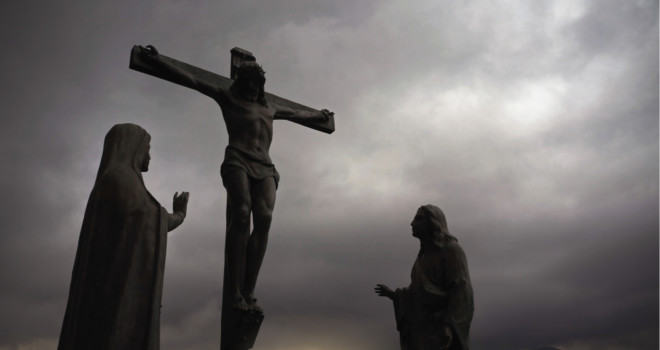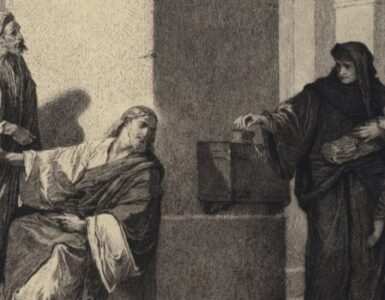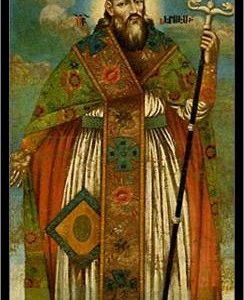When you tread again, with Christian tradition, the road to Calvary, you recall the meeting between Jesus and His Mother; but you notice that there is no word spoken, no action done. It is the same at the end: she stands at the foot of the Cross, but she is silent and still. And indeed, what you notice about the story of the Passion as a whole is the striking contrast between the quiet stillness of those who love Him and the ceaseless activity of His enemies.
The priests are called in haste to the midnight session of the Sanhedrin. The traitor Judas runs to and fro. There is the Temple guards and the Roman soldiery; the agitation of Pilate; the bustle of the palace, probably the unprecedented upset of a visit by night from the high priest. Over all, there is the clamor and movement, the shouting and disturbance, of the Jewish mob. But the central figures are still.
Jesus allows Himself to be led hither and thither, yes, but in Himself He is stillness; He scarcely speaks. Mary follows to the end, but again she is silent; she does nothing: she stands motionless, rigid, supporting her Son. There is something—something absolutely essential—that we must learn from her. Her vocation was to be a mother, wrapped up in the work of her Son. And for many years, for thirty years, that meant a life of ceaseless activity, a life of hard work, for Him. But then the time came when she was no longer needed: He had to begin His own work in the world. And so, as you see in the Gospels, she withdraws into the background. You hear almost nothing of her, until the end. And then she is there; she is with Him — not to work now, not to be active, only to love and suffer and be still. Remember these words in The Man Born to Be King:
When he was small, I washed and fed him; I dressed him in his little garments and combed the rings of his hair. When he cried, I comforted him; when he was hurt, I kissed away the pain; and when the darkness fell, I sang him to sleep. Now he goes faint and fasting in the dust, and his hair is tangled with thorns. They will strip him naked to the sun and hammer the nails into his living flesh, and the great darkness will cover him. And there is nothing I can do. Nothing at all.
Dorothy L. Sayers, The Man Born to Be King: A Play-Cycle on the Life of Our Lord and Saviour Jesus Christ (San Francisco: Ignatius Press, 1990), 289.
It is a terrible thing, a thing we must all at some time have suffered, that feeling that someone you love is suffering and you can do nothing to help. And yet these words of Mary are not said in despair. And we, too, if we have to say something like them, must not despair. This is the first lesson we are to learn from her.
There are two sorts of activity. There is outgoing activity: the healing work of the hands, the comforting word, the little service that can bring consolation; and sometimes these are impossible. But there is another sort of activity, a purely inward activity, and this is always possible and always healing. And this is the activity of thought and of love and of the lovely child of these two, which we call sympathy. You may have to say, “There is nothing I can do, nothing of outward activity.” You need never say, purely and simply, “There is nothing I can do.” It is our Lady herself who, later on in the same reconstruction of the Passion, says, “Be still, sister, be still: we have no need of words, my Son and I.”
Silence and Stillness
Be still: the stillness and the silence of Mary are the signs not of defeat but of intense and creative activity. There are times when outward busyness only makes matters worse, when, though it may bring you yourself relief, it must be for the other, at best, ineffectual and, at worst, an additional exacerbation of suffering.
Be still: there are times when, if only you are still enough and wise enough, you can learn that all these outward activities of themselves cannot heal, that only love can heal. There is nothing that Mary can do or say; no, but they have no need of words, her Son and she: it is love that heals. And so, when you follow with love and sorrow this story of the Cross, and you want to help; you want to do something for the pain and the sorrow; you want to comfort, never think that there is nothing you can do.
Think deeply and love deeply, and then you will have no need of words: your sympathy, your co-suffering, will go straight from your own heart to the heart of Christ. Rather, it was already there as He trod the way of the Cross those many centuries ago, was already there to comfort Him as His silent Mother was there to comfort Him, and is with Him now and for all eternity as part of His bliss. There is never nothing that you can do.
And the same thing is true if you are thinking of the sorrow and suffering with which the world is filled today. If your heart is with Christ, who suffered for the sins that have made this suffering, then you will long to do something to lessen it, to heal, and to help; but perhaps you will have the bitterness of knowing that as far as outward activity is concerned, there is nothing you can do. Never mind. The same thing is true: you can co-suffer in your heart, and it is love that heals.
We are not blind materialists, to suppose that only material things can really help the sorrow of the human heart. On the contrary, we know how often those material things themselves are powerless to affect anything but the surface, how often indeed they can make the suffering worse when they are not the fruit of love.
We are not blind materialists, to suppose that physical distance is an insuperable barrier to help and healing. On the contrary, we know the power of the human spirit to conquer space as it can conquer time. We know, above all, how the spirit that is one with the spirit of Christ can bring from Him the same healing touch that physically, long ago in Palestine, brought life and joy and wholeness to the world.
Be comforted then; for it is always in your power to bring comfort to others. That is the first lesson we can learn from Mary at the foot of the Cross.
✠
Editor’s note: This article is adapted from a chapter in Fr. Vann’s The Pain of Christ and the Sorrow of God: Lenten Meditations, available through Sophia Institute Press.










